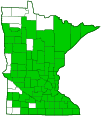wild leek
(Allium tricoccum)
Conservation • Wetland • Description • Habitat • Ecology • Use • Distribution • Taxonomy
Description |
||
Wild leek is a 4″ to 12″ tall, erect, perennial, forb rising from 2 to 6 clustered bulbs. All parts of the plant, including the flower, have a strong onion odor. The bulbs are ⅔″ to 2⅓″ tall and ⅔″ to 1⅛″ wide, but usually more than 1½″ tall and more than ¾″ wide. They are egg-shaped to cone-shaped. They are encased in a brownish or grayish membranous coating. Two to three basal leaves arise tightly rolled together at the soil surface. Later they spread, forming a basal rosette. They are 8″ to 12″ long, 1″ to 3″ wide, solid, flat, and untoothed. They are either lance-shaped, tapering to a point at the tip and tapering gradually to the stalk at the base, to narrowly oval, widest at the middle and narrower at the two equal ends. They are on ¾″ to 2⅓″ long, distinct, slender, reddish leaf stalks. The leaves die back before the flower is fully expanded and functioning. A single, leafless, hairless, round flowering stem (scape) rises 10″ to 14″ from the center of the rosette of leaves. It is curved or bent slightly toward the top, somewhat zigzagged. The inflorescence is a single umbrella-like flowering cluster (umbel) at the top of the scape. The cluster is 1¼″ in diameter, erect, and shaped like half of a sphere. It has 30 to 50 flowers and no bulblets. There are two large bracts (spathe), ½″ to 1⅛″ long, at the base of the cluster. The spathe surrounds and enclose the cluster and is split on one side. It does not fall off but remains even as the fruits develop. The flowers are ¼″ long and bell-shaped. They are composed of 6 white to cream tepals (3 petals and 3 sepals that are similar in appearance). The tepals are erect and have blunt tips. They remain on the plant even as the fruit develops. They are on ⅜″ to ¾″ long flower stalks, the inner ones on shorter stalks, the outer ones on longer stalks, like an umbrella. The fruits form a small ball-like cluster at the top of the stem. The fruit is a shiny 3-celled seed capsule, each cell containing 1 seed (the scientific name tricoccum is Latin for three-seeded). |
||
Height |
||
4″ to 12″ |
||
Flower Color |
||
White to cream |
||
Similar Species |
||
This species is distinguished from other Allium species by the leaves that disappear by flowering time. The leaves are also wider than those of any other Allium species in Minnesota. Narrow-leaved wild leek (Allium burdickii), as its common name indicates, has narrower leaves, ¾″ to 1¼″ wide. They are nearly stalkless or on much shorter leaf stalks, and the stalks are green, not reddish. The bulbs are shorter, ¾″ to 1½″ tall. The scape is much shorter, 5″ to 6¼″ tall. The spathe bracts are smaller, ⅜″ to ¾″ long. The umbel has 12 to 18 individual flowers. Lily of the valley (Convallaria majalis) has similar leaves but they are shorter, 6″ to 9″, and much wider, 1″ to 5″ wide. The inflorescence is a loose, elongated clusted of nodding flowers. |
||
Habitat |
||
Moist. Rich woods. Dappled sunlight. |
||
Ecology |
||
Flowering |
||
May to July |
||
Pests and Diseases |
||
|
||
Use |
||
|
||
Distribution |
||||
|
Sources |
|||
| 5/18/2023 | ||||
Nativity |
||||
Native |
||||
Occurrence |
||||
|
||||
Taxonomy |
|||
| Kingdom | Plantae (Plants) | ||
| Division | Tracheophyta (Vascular Plants) | ||
| Subdivision | Spermatophytina (Seed Plants) | ||
| Class | Liliopsida (Monocots) | ||
Order |
Asparagales (Agaves, Orchids, Irises, and Allies) | ||
Family |
Amaryllidaceae (Amaryllis, Onions, and Allies) | ||
| Subfamily | Allioideae (Onion) | ||
| Tribe | Allieae | ||
Genus |
Allium (onion) | ||
| Subgenus | Anguinum | ||
| Section | Anguinum | ||
Synonyms |
|||
Allium pictum Allium tricoccum var. tricoccum Allium triflorum Ophioscorodon tricoccum Validallium tricoccum |
|||
Common Names |
|||
ramp ramps small white leek wild leek wild onion wood leek |
|||
Glossary
Bract
Modified leaf at the base of a flower stalk, flower cluster, or inflorescence.
Elongate
Drawn out, lengthened.
Scape
An erect, leafless stalk growing from the rootstock and supporting a flower or a flower cluster.
Sepal
An outer floral leaf, usually green but sometimes colored, at the base of a flower.
Spathe
One or two large bracts that subtend, hood, or sometimes envelope a flower or flower cluster, as with a Jack-in-the-pulpit.
Tepal
Refers to both the petals and the sepals of a flower when they are similar in appearance and difficult to tell apart. Tepals are common in lilies and tulips.
Umbel
A flat-topped or convex umbrella-shaped cluster of flowers or buds arising from more or less a single point.
Visitor Photos |
|||||
Share your photo of this plant. |
|||||
| This button not working for you? Simply email us at info@MinnesotaSeasons.com. Attach one or more photos and, if you like, a caption. |
|||||
|
|||||
MinnesotaSeasons.com Photos |
|||||
Plant |
|||||
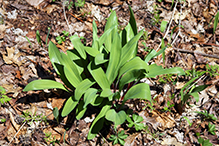 |
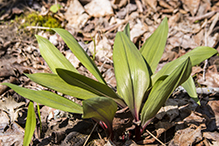 |
||||
Inflorescence |
|||||
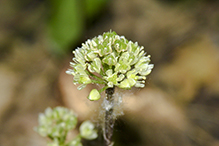 |
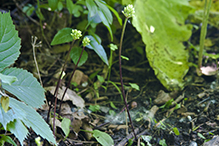 |
||||
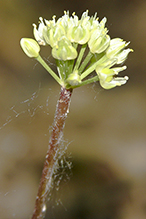 |
|||||
Flowers |
|||||
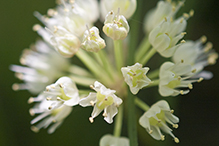 |
|||||
Bud |
|||||
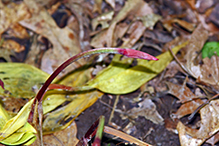 |
|||||
Leaves |
|||||
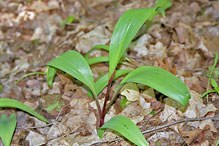 |
|||||

Slideshows |
||
| Small White Leek (Allium tricoccum) Andree Reno Sanborn |
||
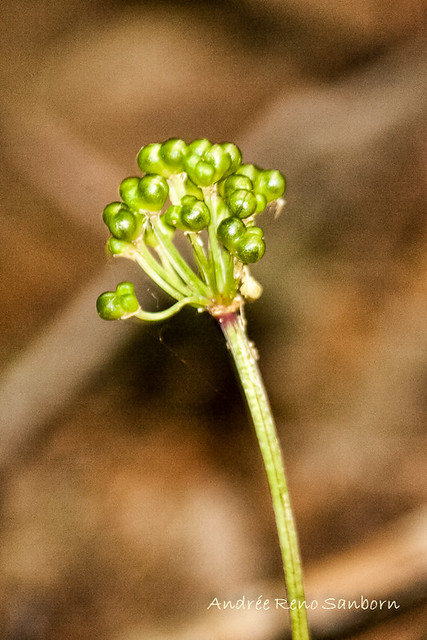 |
||
| Allium tricoccum (Wild Leek) Allen Chartier |
||
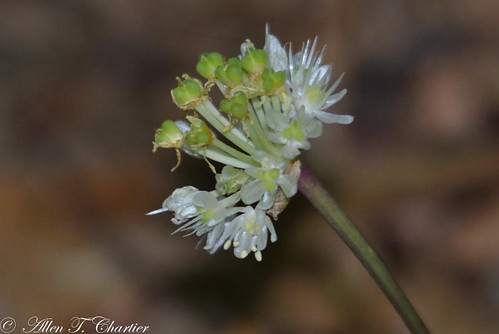
|
||

Visitor Videos |
|||
Share your video of this plant. |
|||
| This button not working for you? Simply email us at info@MinnesotaSeasons.com. Attach a video, a YouTube link, or a cloud storage link. |
|||
Other Videos |
|||
| What are Ramps? (Allium tricoccum) Forest Farming |
|||
About
Published on Jul 1, 2013 Spring is the time to harvest ramps, a popular forest vegetable in the eastern United States. This savory plant is a member of the onion family closely related to leeks. In early spring, ramps send up smooth, broad, lily-of-the-valley like leaves that disappear by summer before the white flowers appear. The whole plant is edible and has a garlic-like aroma and is usually three or more years old when harvested. |
|||
| Life Cycle of a Ramp (Allium tricoccum) Forest Farming |
|||
About
Published on Jul 1, 2013 In this video we review the stages of a ramp's reproduction and life cycle. Ramps have a very short window in which to store up carbohydrates for the year. In the spring, before the forest canopy grows thick and blocks out light reaching the forest floor, ramps must soak up the sun and store the carbohydrates in their roots. |
|||
| Wild Leek (Ramps) - Allium tricoccum PrairieMoonNursery |
|||
About
Uploaded on Dec 28, 2009 http://www.prairiemoon.com - Wild Leeks, often called Ramps, are highly desirable by Forager's in early spring because they are edible. Watch as Steve, Senior Ecologist at Prairie Moon Nursery, points out a native woodland setting where Wild Leeks grow. |
|||
| Ramps or wild leeks (Allium tricoccum) video wvoutdoorman |
|||
About
Uploaded on Jan 9, 2010 L'Ail des bois du printemps à l'automne. Ajo de monte de la primavera hasta el otoño. Wild Garlic from spring to fall. |
|||
| 03 Allium tricoccum Séquence 5-Vivaces printanières 1.m4v Jean Désorcy |
|||
About
Uploaded on Jan 9, 2010 L'Ail des bois du printemps à l'automne. Ajo de monte de la primavera hasta el otoño. Wild Garlic from spring to fall. |
|||

Visitor Sightings |
|||||
Report a sighting of this plant. |
|||||
| This button not working for you? Simply email us at info@MinnesotaSeasons.com. Be sure to include a location. |
|||||
| Bonnie 4/29/2021 |
Location: Yellow Medicine County Lots and lots of them |
||||
MinnesotaSeasons.com Sightings |
|||||
Cannon River Turtle Preserve SNA Clinton Falls Dwarf Trout Lily SNA Forestville/Mystery Cave State Park Hardscrabble Woods / MG Tusler Sanctuary Lake Alexander Woods SNA, South Unit Mary Schmidt Crawford Woods SNA Nerstrand Big Woods State Park P.N. and G.M. Nelson Wildlife Sanctuary Prairie Creek WMA, Koester Prairie Unit |
|||||

|
Created: Last Updated: © MinnesotaSeasons.com. All rights reserved. |
